西南大西洋阿根廷滑柔鱼耳石元素组成
陆化杰, 陈新军,*,方 舟
1 上海海洋大学海洋科学学院, 上海 201306 2 国家远洋渔业工程技术研究中心, 上海 201306 3 上海海洋大学大洋渔业可持续开发省部共建教育部重点实验室, 上海 201306
西南大西洋阿根廷滑柔鱼耳石元素组成
陆化杰1,2,3, 陈新军1,2,3,*,方 舟1
1 上海海洋大学海洋科学学院, 上海 201306 2 国家远洋渔业工程技术研究中心, 上海 201306 3 上海海洋大学大洋渔业可持续开发省部共建教育部重点实验室, 上海 201306
耳石微量元素越来越广泛地被用于头足类群体划分、洄游史等领域的研究。根据我国鱿钓船2007、2008和2010年在西南大西洋生产期间采集的阿根廷滑柔鱼样本,利用激光剥蚀电感等离子质谱法(Laser ablation inductively coupled plasma mass spectrometry, LA-ICP-MS)按不同群体、不同性别和不同生长阶段,分析了33枚阿根廷滑柔鱼耳石的元素组成及分布特性。结果表明,阿根廷滑柔鱼耳石主要由56种元素组成,含量最多的前10种元素分别为钙Ca、锶Sr、钠Na、磷P、钾K、铁Fe、镁 Mg、钡Ba、硼B、镓Ga。方差分析表明(ANOVA),不同性别间Ca、Sr、Na、P、K、Fe、 Mg、Ba、B、Ga都不存在显著性差异(P>0.05)。冬季孵化群和秋季孵化群间耳石的Sr、Na、Mg、Ba和B存在显著性差异(P<0.05),Ca、P、K、Fe和Ga则不存在显著性差异(P>0.05)。耳石的核心区、后核心区、暗区和外围区等不同部位间的Na、Ba和Ga不存在显著性差异(P>0.05), Ca、Sr、P、K、Fe、Mg和B则存在显著性差异(P<0.05)。研究表明,Sr和Mg含量及其分布特性最适合用于研究阿根廷滑柔鱼的群体划分、洄游史等渔业生态学特性。
阿根廷滑柔鱼; 耳石; 元素组成; 西南大西洋
耳石(statolith)是头足类调节自身平衡的硬组织[1],其生长贯穿整个生命周期,具有不可逆的沉积过程[2],储存了包括反映日龄的生长轮纹[3]、反映生长环境变化的微量元素[4]等重要信息。近些年来,基于头足类耳石微量元素、同位素等微化学成份分析的研究方法,逐渐成为头足类渔业生物学和渔业生态学研究的一种重要手段[5- 9]。阿根廷滑柔鱼Illexargentinus广泛分布于22°—54°S的西南大西洋海域,主要集中于35°—52°S海域[10],资源量丰富[11],是重要经济头足类之一,在海洋生态系统中起着重要的作用[12],也是我国鱿钓渔业重要的目标种类之一[13]。为此,本研究根据中国鱿钓船2007、2008和2010年在西南大西洋海域生产期间采集的阿根廷滑柔鱼耳石样本,利用激光剥蚀电感等离子质谱法(Laser ablation inductively coupled plasma mass spectrometry, LA-ICP-MS)[6,14],分析西南大西洋阿根廷滑柔鱼耳石元素分布与组成,探讨不同性别、不同孵化群体、不同耳石部位元素的沉积特性,为利用耳石元素研究阿根廷滑柔鱼渔业生态学奠定基础。
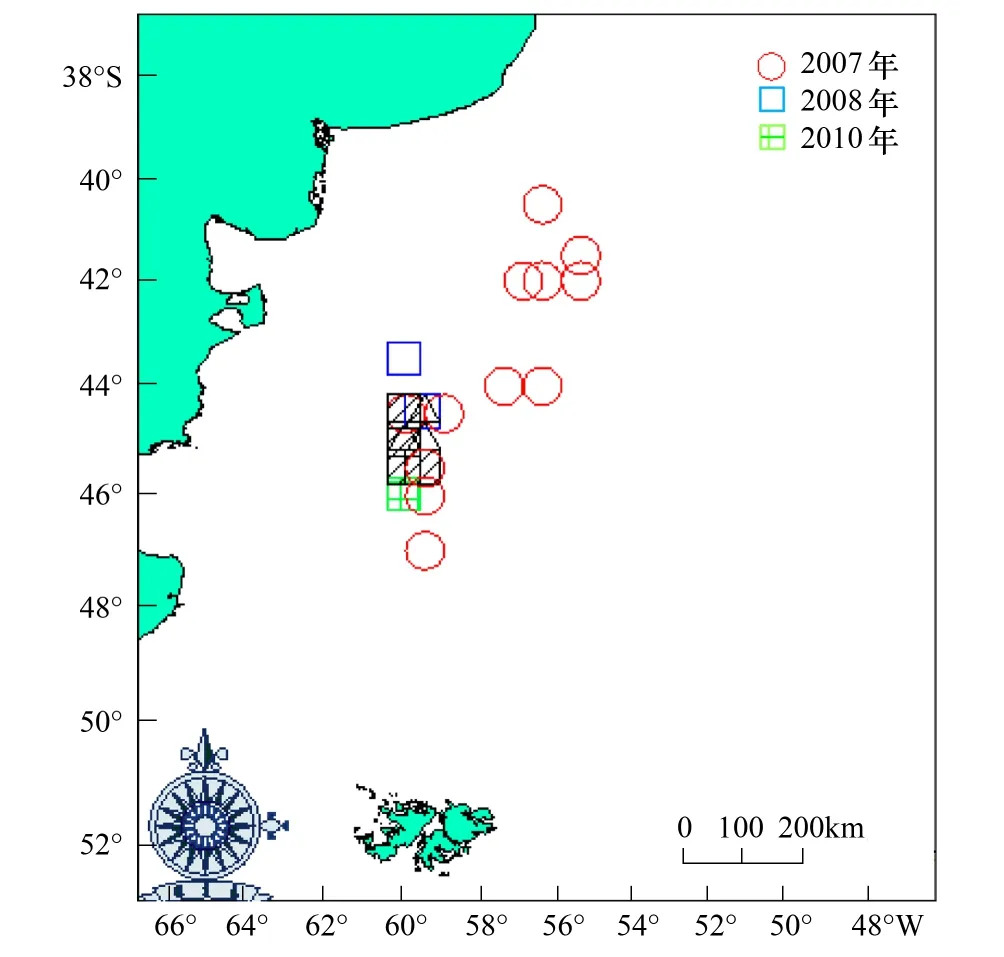
图1 阿根廷滑柔鱼采样分布图 Fig.1 Sampling locations for I. argentinus in the southwestern Atlantic Ocean
1 材料和方法
1.1 材料来源
样本来自“新世纪52号”和“浙远渔807号”专业鱿钓船。时间为2007年2—5月、2008年3—5月和2010年1—3月,采集海域分别为40°02′S —46°53′S、57°55′W— 60°43′W,45°03′S —46°57′S、60°02′W— 60°47′W 和45°17′S —47°14′S、60°0′5W — 60°47′W(图1)。样本采集后立即冷冻保存,带回实验室分析。
1.2 生物学测量及耳石提取
实验室解冻后对阿根廷滑柔鱼进行生物学测定,包括胴长(Mantel length,ML)、体重(Body weight, BW),对性别、性成熟度进行目测,标准参考Lipinski[15]。胴长测定精确至1 mm,重量精确至1 g。
用镊子轻轻将耳石从平衡囊取出、编号,存放于盛有95%乙醇溶液的1.5 mL离心管中,以便溶解、清除包裹耳石的软膜和表面的有机物质。
1.3 样本日龄鉴定及群体划分
利用耳石生长纹研究样本的日龄并进行群体划分,具体参照陆化杰和陈新军[16]。以采样日期(站位)选取样本(日期间隔长),并考虑个体大小、性别比例、孵化日期(不同孵化时间)等指标,选取33尾样本(表1),利用激光剥蚀-电感耦合等离子体质谱仪(LA-ICP-MS)对其耳石微区进行元素测定,测定完毕后,对打点位置进行日龄鉴定。一对耳石中的另外一枚用于测定耳石整体元素组成。样本详细信息见表1。
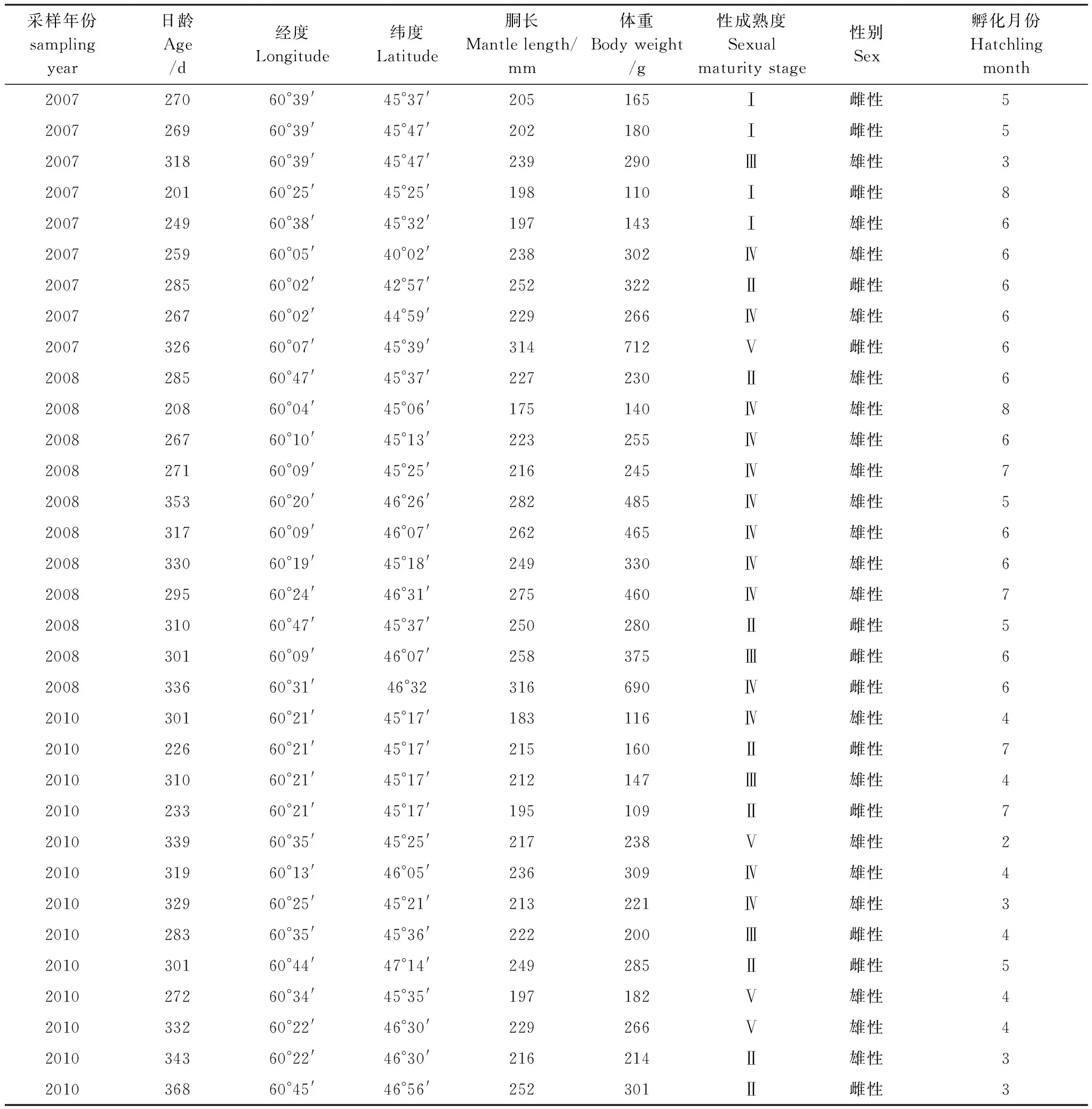
表1 激光剥蚀-电感耦合等离子体质谱仪测试样本列表Table 1 Statolith samples to be tested by LA-ICP-MS
1.4 元素测定
1.4.1 总体元素测定
耳石样品取出后,放入7 mL特弗隆带盖小瓶中,加入120 μL的硝酸,然后放在120 °C的电热板上蒸干。然后再次加入120 μL的硝酸,确保样品完全溶解,在120 °C的电热板上再次蒸干。最后趁热加入250 μL含50×10-9的5%硝酸溶液,盖上盖子等待电感耦合等离子体质谱(ICPMS)测试[6]。
1.4.2 耳石微区元素测定
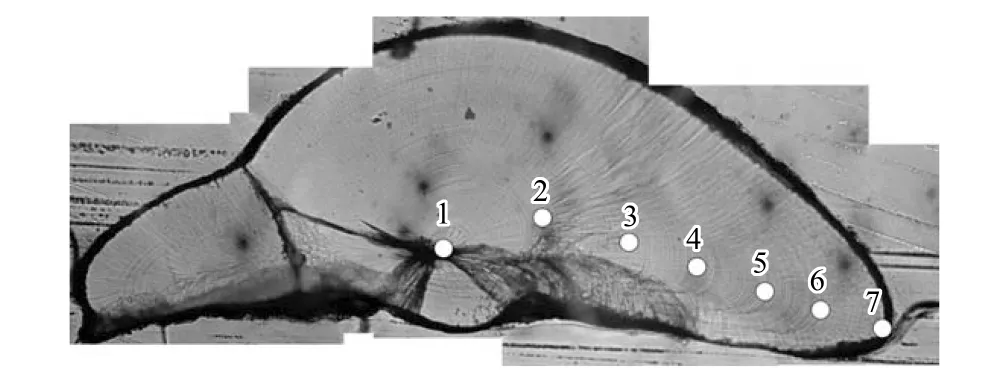
图2 阿根廷滑柔鱼耳石微区元素分析打样点(1: 核心区,2:后核心区,3—4:暗区,5—7:外围区)Fig.2 Analysis points in one of ground statolith of I. argetntinus (Spot 1was in N, Spot 2 was in DZ, Spots 3—4 were in P, Spots 5—7 were in PZ, respectively)
耳石微区元素含量分析在中国地质大学(武汉)地质过程与矿产资源国家重点实验室(GPMR)利用LA-ICP-MS完成。日龄鉴定以后,由耳石中心至背区边缘,在耳石的核心区(Nuclear, N)(1个取样点)、后核心区(Postnuclear, PN)(1个取样点)、暗区(Dark Zone, DZ)(2个取样点)、外围区(Peripheral Zone, PZ)(3个取样点),共选取7个取样点[6, 17](图2)。激光剥蚀系统为Geolas 2005,ICP-MS 为Agilent 7500a。激光剥蚀过程中采用氦气作载气、氩气为补偿气以调节灵敏度,二者在进入ICP之前通过一个T型接头混合。在等离子体中心气流(Ar+He)中加入了少量氮气,以提高仪器灵敏度、降低检出限和改善分析精密度[18]。每个时间分辨分析数据包括大约20—30 s的空白信号和50 s的样品信号,详细的仪器操作条件[19- 20]见表2。
为校正标准,采用多外标、无内标法对元素含量进行定量计算。对分析数据的离线处理(包括对样品和空白信号的选择、仪器灵敏度漂移校正、元素含量计算)采用软件ICPMSDataCal完成[19]。
1.5 数据分析
(1)统计分析阿根廷滑柔鱼耳石元素种类及主要元素组成,并选取含量前10位的元素进行分析。
(2)利用方差分析方法,分析不同性别、不同孵化群体及不同耳石部位(代表不同生长阶段)耳石主要元素值的变化是否存在显著性差异[21]。
(3)量化耳石各区主要元素的变化特性。

表2 LA-ICP-MS工作参数Table 2 Analytical parameters of LA-ICP-MS
2 结果
2.1 耳石元素组成
分析表明,阿根廷滑柔鱼耳石中共检测出Ca等56种元素,其中Ca主要以CaCO3形式存在,各剥蚀点元素总重量的(97.24±0.27)%,含量前10位的元素分别为钙Ca (389025.201±1060.999) mg/kg、锶Sr(7081.959±552.485) mg/kg、钠Na(4707.471±469.436) mg/kg、磷P(416.129±266.052) mg/kg、钾K(223.338±105.227) mg/kg、铁Fe(82.228±12.667) mg/kg、镁 Mg(68.413±56.065) mg/kg、钡Ba(9.715±1.857) mg/kg、硼B(6.111±1.471) mg/kg、镓Ga(1.221±0.254) mg/kg。其余元素分别为钇Sn(0.367±0.208) mg/kg、钪Ce(0.005±0.054) mg/kg、锑Sb(0.036±0.049) mg/kg、锌Zn(1.073±1.892) mg/kg、铷Rb(0.143±0.158) mg/kg、锰Mn(1.392±2.689) mg/kg、镍Ni(0.483±0.833) mg/kg、铜Cu(1.098±2.228) mg/kg、钒V(0.011±0.019) mg/kg、钕Nd(0.002±0.005) mg/kg、铌Nb(7±0.002)×10-4mg/kg、锗Ge(0.072±0.088) mg/kg、镧La(0.001±0.004) mg/kg、钨W(0.003±0.008) mg/kg、钐Sm(0.002±0.006) mg/kg、硒Sc(0.026±0.021) mg/kg、钇Y(0.008±0.006) mg/kg、钼Mo(0.019±0.038) mg/kg、铬Cd(0.029±0.081) mg/kg、钴Co(0.033±0.017) mg/kg、铅Pb(0.283±0.149) mg/kg、钛Ti(0.501±3.889) mg/kg、铬Cr(0.496±0.849) mg/kg、铪Hf(0.002±0.008) mg/kg、镨Pr(6±0.001)×10-4mg/kg、钬Ho(4±0.001)×10-4mg/kg、铀U(0.016±0.012) mg/kg、锆Zr(0.005±0.017) mg/kg、铝Al(1.487±0.661) mg/kg、锂Li(1.921±1.503) mg/kg、银Ag(0.053±0.045) mg/kg、铒Er(8±0.002)×10-4mg/kg、钛Ti(0.501±3.889) mg/kg、钆Gd(0.001±0.004) mg/kg、铋Bi(0.002±0.003) mg/kg、铍Be(3.3±0.007)×10-3mg/kg、镱Yb(0.001±0.003) mg/kg、钽Ta(4±0.001)×10-3mg/kg、钍Th(9±0.004)×10-4mg/kg、铽Tb(6±0.004)×10-4mg/kg、铥Tm(5±0.003)×10-4mg/kg、铯Cs(0.021±0.055) mg/kg、镥Lu(4±0.001)×10-3mg/kg、硅Si(0.983±1.262) mg/kg、镝Dy(0.001±0.003) mg/kg和铕Eu(0.001±0.002) mg/kg。
2.2 不同性别间耳石元素差异
方差分析表明,排在前10位的阿根廷滑柔鱼耳石元素含量性别间均不存在显著性差异,具体为:Ca (F0.0322=0.8577,P>0.05)、Sr(F0.089=0.766,P>0.05)、Na(F0.051=0.822,P>0.05)、P (F0.061=0.806,P>0.05)、K(F0.098=0.755,P>0.05)、Fe(F0.019=0.888,P>0.05)、Mg (F0.951=0.331,P>0.05)、Ba(F0.823=0.365,P>0.05)、B(F0.184=0.669,P>0.05)、Ga (F0.073=1.271,P>0.05)。
2.3 不同孵化群体间耳石元素差异
方差分析表明,冬季孵化群和秋季孵化群间耳石元素Ca (F0.0322=0.8577,P>0.05)、 P (F0.061=0.806,P>0.05)、K (F0.098=0.755,P>0.05)、Fe (F0.019=0.888,P>0.05)、Ga (F0.073=1.271,P>0.05)不存在显著性差异,而Sr (F0.569=0.04,P<0.05)、Na (F11.996=0.000,P<0.05)、Mg (F9.094=0.000,P<0.05)、Ba (F3.021=0.029,P<0.05)、B (F3.121=0.048,P<0.05)存在显著性差异。不同群体Sr、Na、Mg、Ba、B随着日龄变化如图3所示。Sr、Na、B尽管在数量上存在显著性差异,但两个群体间的变化趋势一致,都是冬季孵化群高于秋季孵化群体。Sr随着日龄的增加而先增加后减小,并且在日龄为120 d时达到峰值,然后减小;Na则随着日龄增加而先减小再增加,并且在日龄为270 d时达到峰值,此后减小;B随着日龄增加也先减小后增加,冬季孵化群在180 d时达到最小值,秋季孵化群则在120d时含量最小。Mg的含量冬季孵化群也高于秋季孵化群体,但变化趋势不一致,冬季孵化群随着日龄增加而减小,日龄为270 d时达到最小值,此后略有增加;秋季孵化群体则随着日龄的增加而先减小后增加,并且日龄为60 d时最小,此后逐渐增加。Ba的含量不同群体间数量、变化趋势都不一致,冬季孵化群体随着日龄的增加先减小后增加,而秋季孵化群体则先增加后减小,并且日龄小于120 d时冬季孵化群体高于秋季群体,而150—270 d时,则秋季孵化群体高于冬季孵化群体(图3)。
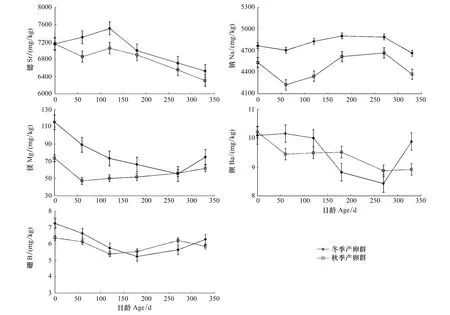
图3 阿根廷滑柔鱼耳石元素随日龄变化分布图Fig.3 Distribution of elements by age in statolith of I. argentinus
2.4 不同耳石部位主要元素差异
虽然不同群体间阿根廷滑柔鱼耳石元素存在显著性差异,但不同耳石部位间元素变化趋势基本一致(图4): Ca、Sr、P、K和B在N 区、PN区、DZ和PZ都存在显著性差异(P< 0.05),其中Ca呈现逐渐增加的趋势,Sr从N区到DZ区逐渐增加,之后急剧下降,总体呈现一个倒“U”型,P和K总体呈现逐渐减小趋势, B先减小到DZ区以后急剧增加,总体呈现一个正“U”型;Fe只有在DZ和PZ区存在显著性差异(P< 0.05),并且呈现逐渐增加趋势(图4f);Mg只有N区和PZ区存在显著性差异(P< 0.05),呈现先增加后减小趋势;而Na、Ba和Ga则不存在显著性差异(P> 0.05)(图4)。
3 分析和讨论
3.1 耳石元素组成
研究结果表明,阿根廷滑柔鱼耳石含有 Ca等56种元素,含量前10位的元素分别为Ca、Sr、Na、P、K、Fe、Mg、Ba、B、Ga。而马金[22]对西北太平洋柔鱼耳石的研究表明,其耳石含有钙Ca等47种元素,其中Ca含量最高,其它按含量大小分别是Na、Sr、K、Fe、Mg、Zn、Cu、Ba、Ni等。Liu等[23]的研究显示,秘鲁外海茎柔鱼耳石含有Ca等47种元素,前10位分别为Ca、Sr、Na、Si、K、Mg、Ba、Mn、Zn和Li。对比表明,虽然同属于柔鱼科,但西南大西洋阿根廷滑柔鱼、西北太平洋柔鱼和秘鲁外海茎柔鱼耳石中主要元素并不完全相同,这可能和它们不同的分布海域相关,也可能和耳石自身的元素沉积特性有关,因为头足类耳石元素的沉积不光受到温度、盐度、食物、光照等环境因子的影响[24],同时也受生长发育、新陈代谢等内在因素的影响[25]。
3.2 不同性别间耳石元素差异
不同性别间阿根廷滑柔鱼耳石元素含量前10位的Ca、Sr、Na、P、K、Fe、Mg、Ba、B、Ga的含量都不存在显著性差异。Doubleday[26]研究发现毛利蛸(Octopusmaorum) 和苍白蛸 (Octopuspallidus) 耳石中微量元素除了Ni 和 Co以外,都不存在性别间差异。Durholtz 等[27]研究显示,真枪乌贼 (Loligovulgaris)耳石中Sr和Ca的沉积也不存在性别间的差异,这些结果在本研究中得到了验证。在目前出版的文献中,未见雌雄个体洄游方式与路线不同的同一头足类,因此对于同一群体,不同性别的个体经历的生活史相同,如果元素的沉积存在性别间差异,说明个体对于元素的吸收受到自身新陈代谢的影响大于海洋环境的影响[25],
3.3 不同孵化群体耳石元素差异
研究结果表明,冬季孵化群体和秋季孵化群体Sr、Na、Mg、Ba和B存在显著性差异,而Ca、P、K、Fe和Ga则不存在差异性。元素Sr、Na、Mg、Ba和B的含量存在群体间的显著性差异性,可能和不同孵化群体经历的不同的孵化时间、不同的孵化地点、不同生活环境相关和不同的摄食特性相关[6,24- 25]。Zumholz等[24]通过对乌贼(Sepiaofcinalis)耳石微量元素的研究,认为其Ca、Ba和Sr的沉积与生长环境中的盐度密切相关,并且Sr在耳石上的含量与其生活海域的温度成反比。Durholtz等[27]通过对毛利蛸耳石中的微量元素分析,发现除了Cu 和 Zn以外,微量元素Pb、Mn、Mg、砷As、Co 和 Ba都存在地域间的差异。元素Ca、P、K、Fe和Ga含量不存在群体间的差异,可能说明这些元素的沉积特性不适合用于研究阿根廷滑柔鱼的群体划分。
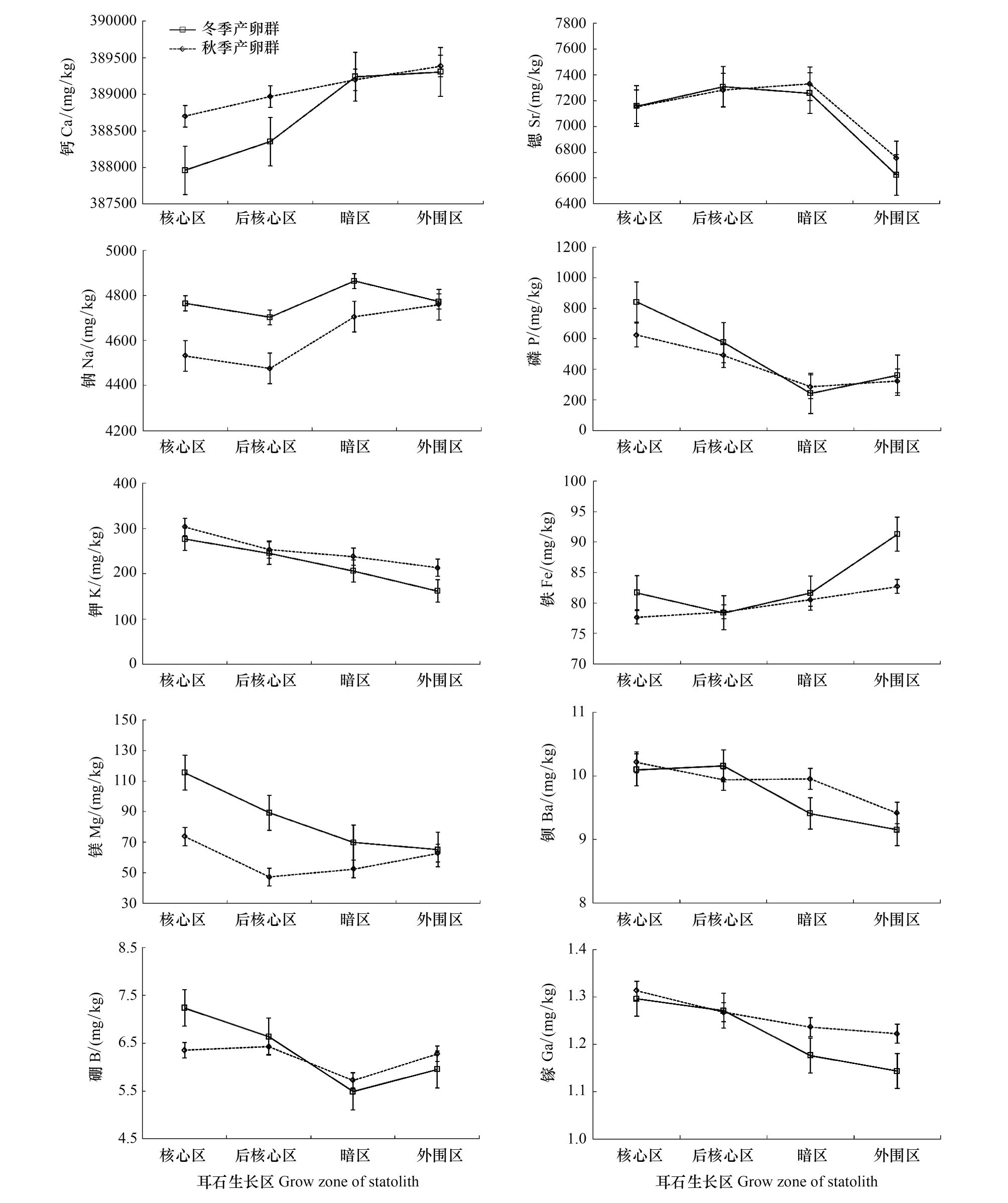
图4 LA-ICP-MS测定的不同耳石部位阿根廷滑柔鱼耳石元素分布Fig.4 Element measured with LA-ICP-MS in different growth zone in statolith of I. argentinus from the nucleus to the edge
3.4 不同耳石部位元素差异
在阿根廷滑柔鱼耳石含量前10位的元素中,除了Na、Ba和Ga外,Ca、Sr、P、K、Fe、Mg和B在耳石不同部位的含量均存在显著性差异。这些显著性差异可能与耳石不同的生长阶段所经历的生活环境有关。Durholtz等[27]研究表明,真枪乌贼耳石微量元素幼鱼期,Sr主要聚集在翼区及附近区域,而Ca则在侧区含量最高。不同微量元素在头足类耳石不同的部位分布的差异性,不利于利用微量元素研究头足类的群体划分,但一些学者认为头足类胚胎期耳石的微量沉积特性可以用于研究头足类群体划分[26]。
3.5 Sr和Mg研究洄游史的优越性
本研究结果表明,阿根廷滑柔鱼耳石含量前10位的元素中,Ca、P、K、Fe和Ga含量不存在群体间的差异,这就意味着不可能利用这些元素研究阿根廷滑柔鱼洄游史。因为,对于短生命周期的头足类,不同的孵化群体所经历的洄游路线不同[16],即生长的海洋环境不同,而这些元素的沉积不存在显著性差异,说明海洋环境并不是影响这些元素沉积的主要因素。本研究结果还表明,不同耳石部位间阿根廷滑柔鱼耳石Na、Ba和Ga的沉积不存在显著性差异。而在阿根廷滑柔鱼的整个生命周期中,不同耳石部位对应不同的成长阶段,而不同的生长阶段所面临的生活环境不同(海洋环境不同)[6, 10],这些元素的沉积不存在显著性差异,也同样意味着海洋环境对其沉积的影响不显著,因此,Na、Ba和Ga也不适合用于研究阿根廷滑柔鱼洄游史。含量前十位的元素中,只有Sr和Mg的沉积,即不存在性别间差异、又存在群体间和不同耳石部位间差异,综上所述,Sr和Mg最适合用于研究阿根廷滑柔鱼的生活史。
[1] Arkhipkin A I, Bizikov V A. Role of the statolith in functioning of the acceleration receptor system in squids and sepioids. Journal of Zoology, 2000, 250(1): 31- 35.
[2] Radtke R L. Chemical and structural characteristics of statoliths from the short-finned squidIllexillecebrosus. Marine Biology, 1983, 76(1): 47- 54.
[3] Jackson G D. Application and future potential of statolith increment analysis in squids and sepioids. Canadian Journal of Fisheries and Aquatic Sciences, 1994, 51(11): 2612- 2625.
[4] Arkhipkin A I. Statoliths as ‘black boxes’ (life recorders) in squid. Marine and Freshwater Research, 2005, 56(5): 573- 583.
[5] Tshchetinnikov A S, Topal S K. La Composición de la Dieta de los CalamaresIllexargentinusyLoligopatagonicaen el Litoral Argentino.Comisión Técnica Mixta del Frente Marítimo, Montevideo: Resúmenes del VIII Simposio Científico, 1991: 27- 27.
[6] 陆化杰. 西南大西洋阿根廷滑柔鱼渔业生物学及资源评估 [D]. 上海: 上海海洋大学, 2012.
[7] Arkhipkin A I, Campana S E, FitzGerald J, Thorrold S R. Spatial and temporal variation in elemental signatures of statoliths from the Patagonian longfin squid (Loligogahi). Canadian Journal of Fisheries and Aquatic Sciences, 2004, 61(7): 1212- 1224.
[8] Ikeda Y, Arai N, Kidokoro H, Sakamoto W. Strontium: calcium ratios in statoliths of Japanese common squidTodarodespacificus(Cephalopoda: Ommastrephidae) as indicators of migratory behavior. Marine Ecology Progress Series, 2003, 251: 169- 179.
[9] Yatsu A, Mochioka N, Morishita K, Toh H. Strontium/Calcium ratios in statoliths of the neon flying squid,Ommastrephesbartrami(Cephalopoda), in the North Pacific Ocean. Marine Biology, 1998, 131(2): 275- 282.
[10] 王尧耕, 陈新军. 世界大洋性经济柔鱼类资源及其渔业. 北京: 海洋出版社, 2005: 190- 194.
[11] FAO. FAO Yearbook of Fisheries Statistics. Rome: Food and Agricultural Organization of the United Nations, 2008: 27- 27.
[12] Alexander A, Vladimir L. Seasonal and interannual variability in growth and maturation of winter-spawningIllexargentinus(Cephalopoda, Ommastrephidae) in the Southwest Atlantic. Aquatic Living Resources, 1994, 7(4): 221- 232.
[13] 陈新军, 陆化杰, 刘必林, 田思泉. 大洋性柔鱼类资源开发现状及可持续利用的科学问题. 上海海洋大学学报, 2012, 21(5): 831- 840.
[14] Zumholz K, Klügel A, Hansteen T H, Piatkowski U. Statolith microchemistry traces the environmental history of the boreoatlantic armhook squidGonatusfabricii. Marine Ecology Progress Series, 2007, 333: 195- 204.
[15] Lipiński M R, Underhill L G. Sexual maturation in squid: quantum or continuum? South African Journal of Marine Science, 1995, 15(1): 207- 223.
[16] 陆化杰, 陈新军. 利用耳石微结构研究西南大西洋阿根廷滑柔鱼的日龄、生长与种群结构. 水产学报, 2012, 36(7): 1049- 1056.
[17] 陆化杰, 陈新军, 方舟, 刘必林. 西南大西洋阿根廷滑柔鱼耳石微结构及生长特性研究. 渔业科学进展, 2012, 33(3): 15- 25.
[18] Hu Z C, Gao S, Liu Y S, Hu S H, Chen H H, Yuan H L. Signal enhancement in laser ablation ICP-MS by addition of nitrogen in the central channel gas. Journal of Analytical Atomic Spectrometry, 2008, 23(8): 1093- 1101.
[19] Liu Y S, Hu Z C, Gao S, Günther D, Xu J, Gao C G, Chen H H.Insituanalysis of major and trace elements of anhydrous minerals by LA-ICP-MS without applying an internal standard. Chemical Geology, 2008, 257(1/2): 34- 43.
[20] 郑曙, 胡兆初, 史玉芳. 橄榄石中Ni、Ca、Mn含量的电子探针与激光等离子体质谱准确分析. 地球科学——中国地质大学学报, 2009, 34(1): 220- 224.
[21] Doubleday Z A, Pecl G T, Semmess J M, Danyushevsky L. Using stylet elemental signatures to determine the population structure ofOctopusmaorum. Marine Ecology Progress Series, 2008, 360: 125- 133.
[22] 马金. 西北太平洋柔鱼耳石微结构及微化学研究 [D]. 上海: 上海海洋大学, 2010.
[23] Liu B L, Chen X J, Chen Y, Lu H J, Qian W G. Trace elements in the statoliths of jumbo flying squid off the Exclusive Economic Zones of Chile and Peru. Marine Ecology Progress Series, 2011, 429: 93- 101.
[24] Zumholz K, Hansteen T H, Piatkowski U, Croot P L. Influence of temperature and salinity on the trace element incorporation into statoliths of the common cuttlefish (Sepiaofficinalis). Marine Biology, 2007, 151(4): 1321- 1330.
[25] Ikeda, Y, Arai N, Sakamoto W, Mitsuhashi M, Yoshida K. Preliminary report on PIXE analysis for trace elements ofOctopusdofleinistatoliths. Fisheries Science, 1999, 65(1): 161- 162.
[26] Doubleday Z A. An Integrative Approach to Understanding the Population Structure and Dispersal Patterns of two Commercial Octopus Species (OctopusmaorumandOctopuspallidus) [D]. Tasmania: University of Tasmania, 2009.
[27] Durholtz M D, Lipinski M R, Przybylowicz W J, Mesjasz-Przybylowicz J. Nuclear microprobe mapping of statoliths of chokka squidLoligovulgarisreynaudiid′Orbigny, 1845. Biological Bulletin, 1997, 193(2): 125- 140.
An analysis of element composition in the statoliths ofIllexargentisnussquid in the Southwest Atlantic Ocean
LU Huajie1,2,3, CHEN Xinjun1,2,3,*, FANG Zou1
1CollegeofMarineSciences,ShanghaiOceanUniversity,Shanghai201306,China2NationalEngineeringResearchCenterforOceanicFisheries,Shanghai, 201306,China3KeyLaboratoryofSustainableExploitationofOceanicFisheriesResources,MinistryofEducation,ShanghaiOceanUniversity,Shanghai201306,China
The shortfin squid,Illexargentinus, is a neritic-oceanic species distributed along the continental shelf and slope waters of Uruguay, Argentina and the Falkland Islands in the Southwestern Atlantic Ocean between latitudes 20° S and 55°S. They occur more abundantly in the area of 35°—52°S,which supports an important jigging fishery on the Patagonian shelf and plays a significant role in the regional ecosystem.I.argentinusis an opportunistic species having rapid growth, a short life cycle, opportunistic feeding, and a high degree of intrapopulation differentiation. Statoliths of cephalopods are small calcareous structures with high resistance to erosion and recording important information all through its life. It is usually used for estimating ages and growth, identifying population structures by analyzing their microstructure, deducing possible migratory routes and reconstructing habitat environment of cephalopods by the analysis of trace elements and isotopes in statolith.Illexargentinussupports an important commercial fishery in the southwest Atlantic. Understanding of population structure, migration and early life history are essential in sustainable exploitation and management of this squid. Elements of 33 statoliths ofI.argentinescollected in the Southwest Atlantic Ocean during 2007, 2008 and 2010 by Chinese squid jig fishing fleets were analyzed with Laser ablation inductively coupled plasma mass spectrometry (LA-ICP-MS) for different hatching groups, sexes and life history stages. The results indicated that the statolith ofI.argentinuscontained 56 elements, and calcium (Ca), strontium (Sr), sodium (Na), phosphorus (P), potassium (K), iron (Fe), magnesium (Mg), barium (Ba), boron (B), gallium (Ga) were the ten most abundant elements. The analysis of variance (ANOVA) showed that there was no significant difference in all element distributions between sexes (P>0.05); however, significant difference existed in the Sr, Na, Mg, Ba, B (P<0.05) and no significant difference was found in the Ca, P, K, Fe and Ga between different hatching groups (P>0.05). Significant difference existed in all of the ten most abundant elements except for Na, Ba and Ga among different growth zones including nuclear part, postnuclear part, dark zone and peripheral zone in statolith (P<0.05). This study suggested that Sr and Mg were the best two trace elements to be used in the study of the population structure and life history ofI.argentines.
Illexargentinus; statolith; trace element; Southwest Atlantic Ocean
国家发改委产业化专项(2159999); 国家863计划(2012AA092303); 国家自然科学基金(NSFC41276156); 上海市科技创新行动计划(12231203900); 上海市捕捞学重点学科(S30702); 农业部大洋渔业资源环境科学观测实验站的资助
2013- 03- 26;
日期:2014- 03- 25
10.5846/stxb201303260514
*通讯作者Corresponding author.E-mail: xjchen@shou.edu.cn
陆化杰, 陈新军,方舟.西南大西洋阿根廷滑柔鱼耳石元素组成.生态学报,2015,35(2):297- 305.
Lu H J, Chen X J, Fang Z.An analysis of element composition in the statoliths ofIllexargentisnussquid in the Southwest Atlantic Ocean.Acta Ecologica Sinica,2015,35(2):297- 305.

